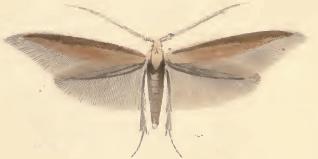
Stachys is a genus of plants, one of the largest in the mint family Lamiaceae. Estimates of the number of species vary from about 300, to about 450. Stachys is in the subfamily Lamioideae and its type species is Stachys sylvatica. The precise extent of the genus and its relationship to other genera in the subfamily are poorly known.
The Cosmopterigidae are a family of insects in the order Lepidoptera. These are small moths with narrow wings whose tiny larvae feed internally on the leaves, seeds and stems of their host plants. About 1500 species are described. The taxonomic family is most diverse in the Australian and Pacific region with about 780 species.

Ecpyrrhorrhoe rubiginalis is a species of moth of the family Crambidae. It was described by Jacob Hübner in 1796 and is found in central and southern Europe.

Muschampia floccifera, the tufted skipper or tufted marbled skipper, is a butterfly of the family Hesperiidae.

Endothenia quadrimaculana is a moth of the family Tortricidae. It is found from northern and central Europe to Siberia and south-eastern Russia, Mongolia and China. Subspecies nubilana is found in North America.
Chamaesphecia mysiniformis is a moth of the family Sesiidae. It is native to the Iberian Peninsula, southern France, and northern Morocco, but has been introduced to Victoria, Australia in 1997.
Anatrachyntis incertulella, the pandanus flower moth, is a small cosmet moth species. It belongs to subfamily Cosmopteriginae. This was the first "micromoth" species to be described from Hawaiʻi. The type specimens were collected there by the 1820s Beechey expedition and described by the English entomologist Francis Walker in 1864; they are now in the British Museum of Natural History.

Coleophora albitarsella is a moth of the family Coleophoridae. It is found in most of Europe, but has not been recorded from Ireland and Greece.

Coleophora wockeella is a moth of the family Coleophoridae. It is found from Latvia to the Iberian Peninsula, Italy and Albania and from Great Britain to southern Russia.

Coleophora virgatella is a moth of the family Coleophoridae. It is found from Germany and Poland to the Pyrenees, Italy and Greece. It has also been recorded from southern Russia and central Asia.

Coleophora auricella is a moth of the family Coleophoridae. It is found from Germany and Poland to Spain, Italy and Romania. It has also been recorded from southern Russia.
Coleophora ballotella is a moth of the family Coleophoridae. It is found from Germany, Poland and the Baltic States to the Iberian Peninsula, Italy and Greece. It has also been recorded from northern and southern Russia.

Coleophora lineolea is a moth of the family Coleophoridae. It is found in most of Europe.

Coleophora ochripennella is a species of moth from the family Coleophoridae. It is found from Germany and Poland to the Pyrenees, Italy and Greece.
Hodgesiella rhodorrhisella is a moth in the family Cosmopterigidae. It is found on the Canary Islands.
Alucita desmodactyla is a moth of the family Alucitidae. It is found in most of Europe, except Ireland, Great Britain, the Benelux, Portugal, Denmark, Fennoscandia, the Baltic region and most of the Balkan Peninsula. It has also been recorded from Armenia and Tunisia. The habitat ranges from slope steppes to fresh deciduous woodlands on altitudes between 90 and 600 meters.
Chamaesphecia dumonti is a moth of the family Sesiidae. It is found from France to southern Russia and the Caucasus and from Germany south to Italy and the Balkan Peninsula., It is also found in western Turkey.

Aristotelia subdecurtella, the brown fen neb, is a moth of the family Gelechiidae. It is found in most of Europe, except Norway, Belgium, Spain, Switzerland, the Czech Republic and most of the Balkan Peninsula. It is also found in the Russian Far East. The habitat consists of wetland areas.

Endothenia nigricostana, the black-edged marble, is a moth of the family Tortricidae. It was described by Adrian Hardy Haworth in 1811. It is found from most of Europe, east to Japan. The habitat consists of woodland margins and embankments.

Clepsis peritana, the garden tortrix or strawberry garden tortrix, is a species of moth of the family Tortricidae. It is found in Spain, Cuba, as well as North America, where it has been recorded from southern Canada throughout the United States.








